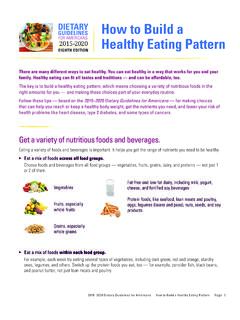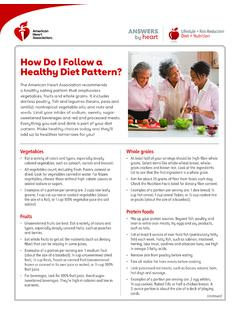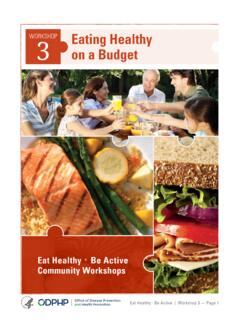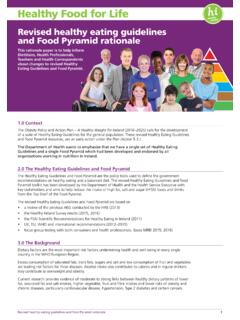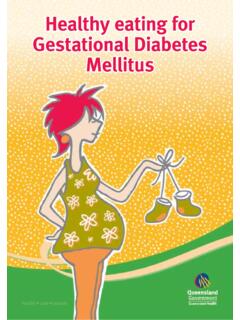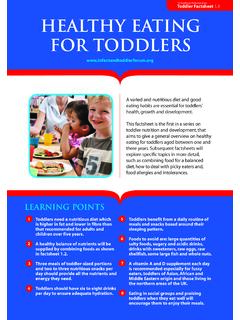Transcription of Obesity, healthy eating and physical activity in primary ...
1 Age group: 5 11 Published: July 2018 Reference no: 180017 Obesity, healthy eating and physical activity in primary schools A thematic review into what actions schools are taking to reduce childhood obesity In 2011, the World Health Organization claimed that childhood obesity is one of the most serious public health challenges of the 21st century. In August 2016, the government published Childhood obesity: a plan for action . As part of the plan, Ofsted has reviewed obesity, healthy eating and physical activity in schools. Obesity, healthy eating and physical activity in primary schools July 2018, No.
2 180017 2 Contents HMCI s commentary 3 School meals 4 A curriculum for healthy living 4 Parents want more PE 5 Background 7 Methodology 8 Research design and methods 8 The impact of schools on BMI 9 Ethos and management 11 Curriculum 12 Sport, physical education and physical activities in the curriculum 13 healthy eating in the curriculum 16 Specialists 17 Access and facilities 18 Attitudes and behaviours 19 Food and drink 22 Meeting the standards 23 School meals 24 Packed lunches 27 Water and snacks 28 Parents and schools together 28 Increasing participation 31 Targeting attitudes 33 Using specialists 34 Findings and observations from other studies 35 Annex A.
3 Methodology 41 Obesity, healthy eating and physical activity in primary schools July 2018, No. 180017 3 HMCI s commentary Childhood obesity is one of the pressing issues of our generation. By the start of primary school, almost a quarter of children in England are overweight or This rises to over a third by the time children leave Year 6. Obesity in children starting Reception has risen for the second year in a row. Naturally, this issue is a high priority for the government, and the recently published obesity strategy sets out the responsibility we all have to support young people in meeting the challenge.
4 Obesity in children happens for complex reasons. Every child is influenced by many factors and we do not have a full understanding of how these factors interact when it comes to individual children. However, the messages reaching children need to consistently reinforce the importance of choices that lead to better health. Without this, the attractions of sugar, fat and inactivity will more often win the day over healthier choices. Schools have an important role to play in reinforcing these messages. They also have responsibility for a curriculum that gives children a solid body of knowledge about healthy living and the skill to pursue it.
5 Children need to learn how our bodies work, why physical health is important and how to prepare food. They need to grow in competence in sport and physical pursuits so that being active is enjoyable for them as well as challenging. Reinforcing messages, imparting knowledge and developing skill are what schools do and do well. In the shared effort to tackle obesity, schools should focus on improving those things they are best placed to do: planning a challenging and well-sequenced curriculum, including learning about the body in PE and science about healthy eating and cooking providing ample opportunity for children to take physical exercise during the school day with lots of opportunities to get out of breath teaching particular skills like how to cook or how to dance updating parents on their children s physical development such as agility, balance and coordination.
6 The contribution of schools is extremely important. But it must be about doing what schools do best: education. We should not imagine that schools alone can have a direct and measurable impact on children s weight. There are too many factors beyond the school gate that make this impossible for them to control. As part of this research, we carefully selected a group of 60 primary schools where we could control for demography (as much as we could within the limits of the 1 Obesity prevalence increases in reception age primary school children , NHS Digital, October 2017; Obesity, healthy eating and physical activity in primary schools July 2018, No.)
7 180017 4work). This gave us a group of schools where obesity seemed high compared with schools that were similar to them, and another group of schools where obesity seemed low, also compared with schools with similar demography. We used this split to look at each of the school-level interventions taking place in these schools, where we had the evidence. When we did this, we saw no pattern to suggest that any intervention was related to higher or lower obesity. This means that individual school-level actions, like having a nominated lead for obesity or having an on-site kitchen, are not likely in themselves to make a significant difference to children s weight.
8 This was not a surprising finding, because we would not expect them to. Obesity is far, far more complex than that. School meals Clearly, the food that schools provide has to be healthy . Our inspectors found no reason to believe that schools are not following the school food standards set by the government. The best school leaders were going much further and were taking a personal interest in the quality of the meals they were providing. It would be economic good sense for schools if more children took up school meals. The government has made a significant financial commitment to providing free infant school meals.
9 It is very puzzling why this is offer has lower take-up in disadvantaged areas compared with wealthier ones. Our evidence did not tell us why and this deserves further investigation. Not only do infant school meals save parents the cost of a packed lunch, but higher take-up makes meals more economic to serve. The cost of school meals is a factor for some parents when pupils reach key stage 2. We saw big differences in approach between the school leaders who took personal ownership for the quality of food and usability of payment and catering procurement, and those who, wrongly, saw themselves as having little control.
10 However, we saw no strong evidence in our research to suggest that packed lunches are playing a significant role in the obesity crisis. Based on the evidence given to us by pupils, what is most likely to be in their packed lunch is a piece of fruit, a packet of crisps, a pot of yoghurt and a ham sandwich. They are mainly drinking water. While it might be worth trying to substitute the crisps for something healthier, swapping this lunch for a school meal is unlikely to be a silver bullet. Certainly, quite a few packed lunches had a biscuit, a chocolate bar or a piece of cake. However, 93% of pupils taking school meals told us they had a pudding.










